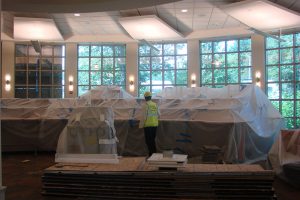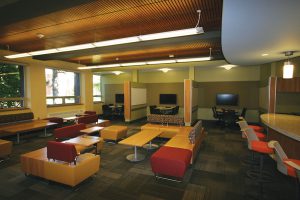Durham, NH Things have changed quite a bit in University campus dining halls since John Belushi attended the mythical Faber College, stuffed his face while waltzing through the line in the college caf and the infamous “Food Fight” that followed. Today, if you take your son or daughter on a trip to a campus for a “visit” you realize that dormitories are now “luxury” accommodations, recreation gyms are state of the art work-out centers and the old dining halls are now the equivalent of 5-star restaurants.
And at the University of New Hampshire, they were fearful of losing one or two of their “stars”.
A press release on Wednesday May 27, 2015 from UNH Media Service accurately described the challenge and the solution:
“Starting in late August, you won’t need to stalk almost-done diners in order to get a seat during rush hour at HoCo. This project will add 350 seats to the dining hall, meaning you’ll be able to linger over your lemon chicken minus impatient glares.”
And so it began, the largest “addition” to a dining hall in the history of the University of New Hampshire (UNH). Students at UNH don’t like to wait in line to eat at Holloway Commons (HoCo). The growing demand for on and off campus students to eat at the campus’ largest and most central dining hall had increased so dramatically that even though there are 2 other dining halls on campus, students waiting line had become a common occurrence during rush hours at HoCo.
How popular is HoCo? The three dining halls on campus have a pre-expansion seating capacity of 2,255. There are 10,200 meal plan holders. When the expansion is complete, HoCo will represent almost 50% of the dining seats and closer to 60% of all diners. “The need for seating at HoCo has grown so that really, the demand is there. We really need to have it,” HoCo manager Deborah Scanlon said.
“The ambitious expansion of our main dining facility is largely designed to alleviate points of congestion for the university’s growing student body, to create a better traffic flow and to ease the transition into the new floor plan. The project also includes a new exterior staircase to replace the old one.” said Bonnie Witt who works for housekeeping at HoCo.
The $10.5 million project had a Garden Terrace Theme. “We want to essentially bring outdoors into the building,” director of dining Jon Plodzik said. “We’re talking about open grid ceilings and large, almost-three story views from upper terraces.”
UNH architect and director of campus planning Douglas Bencks said, “The renovations plans were broken into 3 components, a renovation and two additions. These improvements would be achieved by adding two new seating areas on and over an existing rooftop terrace that is under used. The building’s central stairway and elevator will be shifted in order to allow for the main check-in to be expanded. The renovation piece included taking all exterior mezzanines and moving them into additional indoor seating areas. This includes the rubberized rooftop visible from the second floor of HoCo. The main entrance needed to be moved farther down the current hallway in an effort to open up options for adding two seating areas, expanding the check-in center and a new entrance”.
So, the Monday after graduation 2015, general contractor North Branch kicked off the project. First through the door was demolition specialist EnviroVantage.
EnviroVantage owner Scott Knightly is a graduate of UNH and has partnered with the school on numerous projects. He was keenly aware of the expectation of quality of work and the no-nonsense time line that stated “the renovation and the 1st addition HAD to be completed before school starts again at the end of August.” How important was this time line? Director of UNH dining Jon Plodzik stated it clearly when he was quoted as saying “what is critical to us in this process is that we do not impede the opening of the fall. This is enormous in scope, so we need to provide the contractors enough time to get that portion of the program completed before students return in the fall.”
As the first contractor on site, EnviroVantage (EV) likes to set the tone and tempo of projects. EV project manager Troy Purington did his “homework” and in collaboration with North Branch identified the challenges that were to follow and the solutions. “If you have ever seen this building, it is a beautiful structure but it is built on a hill. Great for beauty – challenging for demolition and renovation.”
Getting in and out of this building was challenge #1 which Purington overcome by using strategically placed lulls to hoist equipment and waste containers in and out of the building.
Second, he noted that the waste materials from the demolition were going to be enormous. For this, EV segregate all waste materials by task, by area, and by quantity to allow for recyclables to be separated out. Specific dumpsters for steel, brick, metal, concrete and general were designated and loaded by category to increase the green capabilities.
Third was the windows. Big windows, 20 feet tall windows that span the length of the building. Purington was especially proud of EnviroVantages’ work on the windows. “The windows were a special ‘save,’ as they had to be carefully removed and then donated to build a green house. These were large store front windows which necessitated removal off of staging and man lifts. The glass panes where removed and then the frames where cut in to sections so they could be loaded out. Two sides of the building were windows 20 feet tall spanning the length of the addition. This was no small task and once removed we worked with North Branch to hang reinforced poly and strapping to keep the building weather tight. Not a lot of rainy days last summer but afternoon showers, thunderstorms, micro burst, really throw a monkey wrench in to things when you have an entire side of a building wide open.”
Fourth was the waste removal. The hilly terrain plus work being performed on the exterior of the building prevented easy removal of the dumpsters. Undaunted, EV tapped into its vast experience of waste removal and created unique 5-pronge attack on the waste removal:
A. Devised a unique plan that used a lull to hoist the dumpsters in and out of the building at specially designated openings;
B: Created a waste chute off the side of a balcony which allowed workers to quickly and efficiently dispose of the rubble;
C: Construction buggies were used to separate waste materials. Dumpsters were lined up at the loading dock, near the service elevator so the buggies could rapidly unload their contents into specific dumpsters for recycling;
D: An automatic schedule of dumpster swap-outs was planned so there was never any time lost due to overflow waste; and
E: Stacked dumpsters were utilized to allow for immediate change out when needed to keep the work continuous and without disruption.
The unique plan of dumpsters-on-a-lull, balcony chutes and buggy disposal kept the waste removal continuous, the locking dock operational and also allowed the student union to continue to use the dock for their daily needs. Oh, did they forget to mention the Student Union component? An additional challenge was that HoCo is attached to the student union which is active during the summer months with camps, new student orientation as well as regular student use so EV had to be sensitive to the activity in the adjacent building.
Purington worked with North Branch’s on-site manager, frequent partners on major projects of this kind, to coordinate a plan that would shift the noisier activity to early mornings and late afternoons/early evenings to minimize the disruption to the workers and students next door.
“North Branch was a wizard in helping to coordinate this” said Purington. “We can get more people, more materials, more equipment, more money, more resources but we can’t get more time and North Branch’s ability to synchronize all the trades was masterful.”
As renovation progressed, “the big surprise” quickly unfolded in the kitchen area (isn’t the kitchen always the hardest part of any project?). The removal of a staircase to increase the kitchen area offered up a revelation when it was realized that hot and cold water lines, gas, electrical and high pressure lines all ran through the staircase area, complicating the demolition and necessitating a coordination with MEP contractors to gently and delicately work around the hazard to open up the space and protect the utilities so work could continue free of hazards.
The underside sheet rock had to be torch cut and the concrete jack-hammer out of the metal stair pans to protect these essential MEP’s that fed the occupied building.
Another “surprise” during the demolition phase was the large amounts of duct work that had to be removed from the attic. With no access for a lull, no windows to “chute” the materials out and no access point for a buggy, all duct work had to be broken down into “carryable” sized pieces and hand carried down a set of stairs to an elevator or carried up to the roof where a lull could lend a helping hand. There was no direct route for load-out assistance.
On August 26, 2015, classes began once again on the beautiful Durham campus and all the students saw, upon their return were more tables in the dining hall and more food choice areas to choose from.
What they didn’t see was how EnviroVantage set the table for this 100 day project that culminated with a renovated dining hall and a major addition, by performing: • Demolition in 30 days including weekends; • Utilizing lulls and scissorlifts; • Cutting edged equipment including the BROKK 100 and the SHERPA 100; • Removing 255.89 tons of waste; • Recycling windows, metal, concrete, and other materials; and • All with 0 work days lost and 0 OSHA violations.
 (1).png)












